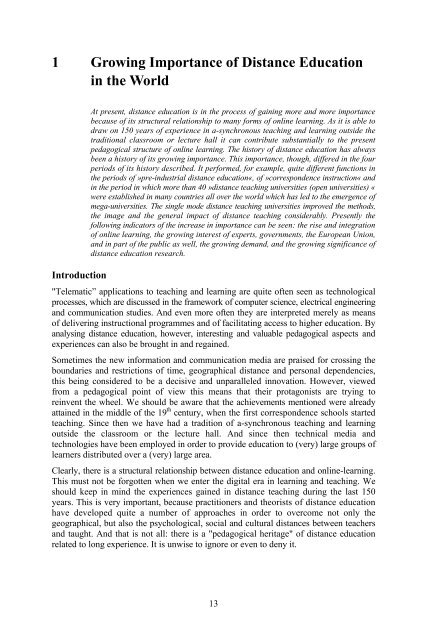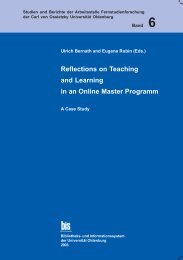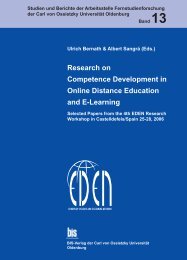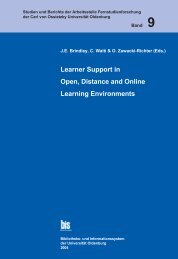Distance Education in Transition - Master of Distance Education ...
Distance Education in Transition - Master of Distance Education ...
Distance Education in Transition - Master of Distance Education ...
You also want an ePaper? Increase the reach of your titles
YUMPU automatically turns print PDFs into web optimized ePapers that Google loves.
1 Grow<strong>in</strong>g Importance <strong>of</strong> <strong>Distance</strong> <strong>Education</strong><br />
<strong>in</strong> the World<br />
Introduction<br />
At present, distance education is <strong>in</strong> the process <strong>of</strong> ga<strong>in</strong><strong>in</strong>g more and more importance<br />
because <strong>of</strong> its structural relationship to many forms <strong>of</strong> onl<strong>in</strong>e learn<strong>in</strong>g. As it is able to<br />
draw on 150 years <strong>of</strong> experience <strong>in</strong> a-synchronous teach<strong>in</strong>g and learn<strong>in</strong>g outside the<br />
traditional classroom or lecture hall it can contribute substantially to the present<br />
pedagogical structure <strong>of</strong> onl<strong>in</strong>e learn<strong>in</strong>g. The history <strong>of</strong> distance education has always<br />
been a history <strong>of</strong> its grow<strong>in</strong>g importance. This importance, though, differed <strong>in</strong> the four<br />
periods <strong>of</strong> its history described. It performed, for example, quite different functions <strong>in</strong><br />
the periods <strong>of</strong> »pre-<strong>in</strong>dustrial distance education«, <strong>of</strong> »correspondence <strong>in</strong>struction« and<br />
<strong>in</strong> the period <strong>in</strong> which more than 40 »distance teach<strong>in</strong>g universities (open universities) «<br />
were established <strong>in</strong> many countries all over the world which has led to the emergence <strong>of</strong><br />
mega-universities. The s<strong>in</strong>gle mode distance teach<strong>in</strong>g universities improved the methods,<br />
the image and the general impact <strong>of</strong> distance teach<strong>in</strong>g considerably. Presently the<br />
follow<strong>in</strong>g <strong>in</strong>dicators <strong>of</strong> the <strong>in</strong>crease <strong>in</strong> importance can be seen: the rise and <strong>in</strong>tegration<br />
<strong>of</strong> onl<strong>in</strong>e learn<strong>in</strong>g, the grow<strong>in</strong>g <strong>in</strong>terest <strong>of</strong> experts, governments, the European Union,<br />
and <strong>in</strong> part <strong>of</strong> the public as well, the grow<strong>in</strong>g demand, and the grow<strong>in</strong>g significance <strong>of</strong><br />
distance education research.<br />
"Telematic” applications to teach<strong>in</strong>g and learn<strong>in</strong>g are quite <strong>of</strong>ten seen as technological<br />
processes, which are discussed <strong>in</strong> the framework <strong>of</strong> computer science, electrical eng<strong>in</strong>eer<strong>in</strong>g<br />
and communication studies. And even more <strong>of</strong>ten they are <strong>in</strong>terpreted merely as means<br />
<strong>of</strong> deliver<strong>in</strong>g <strong>in</strong>structional programmes and <strong>of</strong> facilitat<strong>in</strong>g access to higher education. By<br />
analys<strong>in</strong>g distance education, however, <strong>in</strong>terest<strong>in</strong>g and valuable pedagogical aspects and<br />
experiences can also be brought <strong>in</strong> and rega<strong>in</strong>ed.<br />
Sometimes the new <strong>in</strong>formation and communication media are praised for cross<strong>in</strong>g the<br />
boundaries and restrictions <strong>of</strong> time, geographical distance and personal dependencies,<br />
this be<strong>in</strong>g considered to be a decisive and unparalleled <strong>in</strong>novation. However, viewed<br />
from a pedagogical po<strong>in</strong>t <strong>of</strong> view this means that their protagonists are try<strong>in</strong>g to<br />
re<strong>in</strong>vent the wheel. We should be aware that the achievements mentioned were already<br />
atta<strong>in</strong>ed <strong>in</strong> the middle <strong>of</strong> the 19 th century, when the first correspondence schools started<br />
teach<strong>in</strong>g. S<strong>in</strong>ce then we have had a tradition <strong>of</strong> a-synchronous teach<strong>in</strong>g and learn<strong>in</strong>g<br />
outside the classroom or the lecture hall. And s<strong>in</strong>ce then technical media and<br />
technologies have been employed <strong>in</strong> order to provide education to (very) large groups <strong>of</strong><br />
learners distributed over a (very) large area.<br />
Clearly, there is a structural relationship between distance education and onl<strong>in</strong>e-learn<strong>in</strong>g.<br />
This must not be forgotten when we enter the digital era <strong>in</strong> learn<strong>in</strong>g and teach<strong>in</strong>g. We<br />
should keep <strong>in</strong> m<strong>in</strong>d the experiences ga<strong>in</strong>ed <strong>in</strong> distance teach<strong>in</strong>g dur<strong>in</strong>g the last 150<br />
years. This is very important, because practitioners and theorists <strong>of</strong> distance education<br />
have developed quite a number <strong>of</strong> approaches <strong>in</strong> order to overcome not only the<br />
geographical, but also the psychological, social and cultural distances between teachers<br />
and taught. And that is not all: there is a "pedagogical heritage" <strong>of</strong> distance education<br />
related to long experience. It is unwise to ignore or even to deny it.<br />
13





